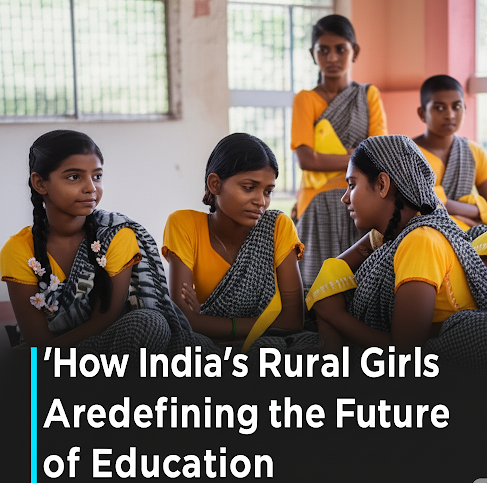How India’s Rural Girls Are Redefining the Future of Education

Introduction
In the dusty lanes of Bihar, the hilly terrains of Meghalaya, and the tribal interiors of Odisha, a quiet revolution is underway. Young girls from rural India are redefining what it means to dream, to lead, and to build a future through education.
In a nation historically challenged by gender disparity, especially in remote areas, the rise of these rural changemakers in 2025 is a powerful testament to the resilience and grit of India’s daughters.
The Numbers and the Gap
Despite progress, a gender gap still persists. According to the Annual Status of Education Report (ASER) 2024, while enrollment among girls at the elementary level has improved, dropout rates after Grade 10 remain high due to economic burdens, early marriage, and lack of infrastructure.
Yet in 2025, the numbers are showing a hopeful shift. National initiatives, increased smartphone access, and localized grassroots interventions are rewriting the narrative.
Stories of Change: Meet the Trailblazers
1. Rani from Jharkhand
At 16, Rani built a solar-powered study lamp for her village using scrap materials. Her innovation went viral when a local NGO uploaded her story to Instagram. She is now pursuing a diploma in renewable energy tech.
2. Shabnam in Rajasthan
Raised in a conservative Muslim family, Shabnam taught herself coding through a donated smartphone and YouTube videos. She now mentors younger girls and created a vernacular language app to help others learn to read.
3. Meera from Assam
With her school closed due to flooding, Meera began recording daily lessons on WhatsApp voice notes for her classmates. Her efforts attracted national media attention, and she now works with a nonprofit on remote education solutions.
These are not isolated stories. They are part of a wider movement.
The Power of Grassroots Organizations
Local organizations have played a pivotal role in shaping these journeys:
- Educate Girls (Rajasthan): Uses community volunteers to enroll girls and track attendance.
- Pratham: Focuses on foundational literacy and numeracy with door-to-door modules.
- Digital Empowerment Foundation (DEF): Brings tech hubs to rural areas, especially for girls.
These programs are often more successful than top-down government schemes because they are culturally sensitive, community-run, and hyper-localized.
Internal link suggestion: Read our story on mental health stigma in India to understand the importance of emotional support in rural schooling.
Tech as an Equalizer
Smartphones and the rise of ed-tech platforms like BYJU’S, Diksha, and Khan Academy in regional languages are democratizing access to education. In 2025, 95% of rural households have access to at least one digital device, according to the Telecom Regulatory Authority of India.
Apps offering video lectures, career counseling, menstrual hygiene education, and STEM workshops are helping girls make informed choices and dream bigger.
However, digital access alone isn't enough. Many girls still rely on community learning centers with shared screens, especially in areas where one device must be shared among siblings.
Barriers That Still Exist
While the stories are heartening, systemic barriers persist:
- Safety Concerns: Long distances to school can put girls at risk.
- Infrastructure Gaps: Schools without toilets, clean drinking water, or female staff reduce retention.
- Early Marriage Pressure: Still a leading cause of dropout for girls aged 14–18.
- Digital Divide by Gender: In many families, boys still get priority for phone or internet access.
Policy alone cannot fix these issues. What’s needed is a cultural shift.
How You Can Help
- Support grassroots education NGOs that focus on girls
- Sponsor a girl’s education through trusted platforms
- Volunteer as a mentor via digital platforms like Mentor Together
- Spread awareness by sharing stories that inspire change
Conclusion: From the Margins to the Frontlines
India’s rural girls are not waiting for saviors. They are becoming their own. Whether through innovation, activism, or sheer perseverance, they are showing the country what real empowerment looks like.
In 2025, they are not just attending school. They are building satellites, launching coding clubs, and running science fairs.
Let us listen. Let us support. Let us amplify.
Know a rural changemaker? DM us—we’d love to highlight her.
Share this blog. Tag a nonprofit making a difference. And if you’re an educator, policymaker, or simply someone who believes in equality—act now.



